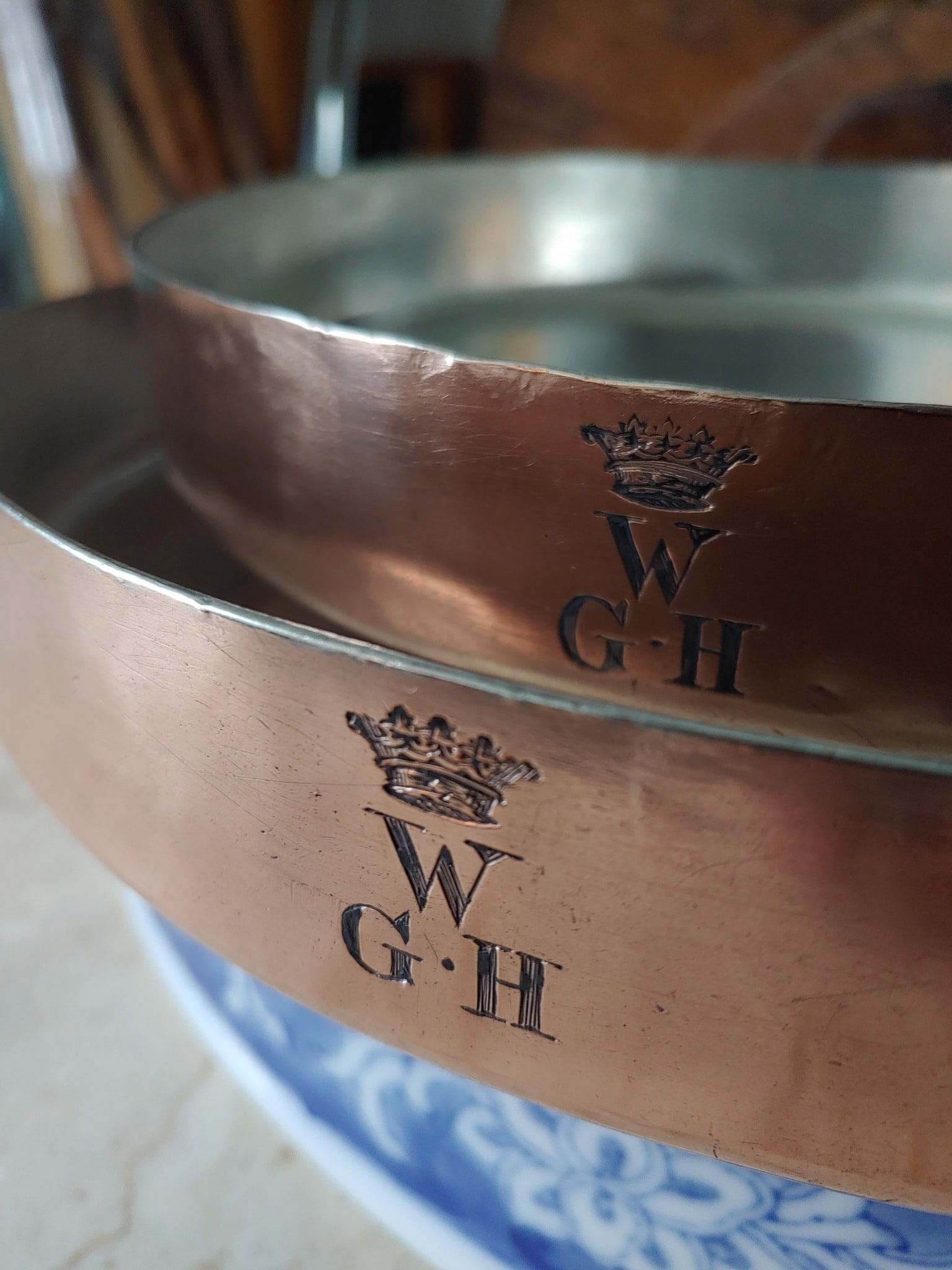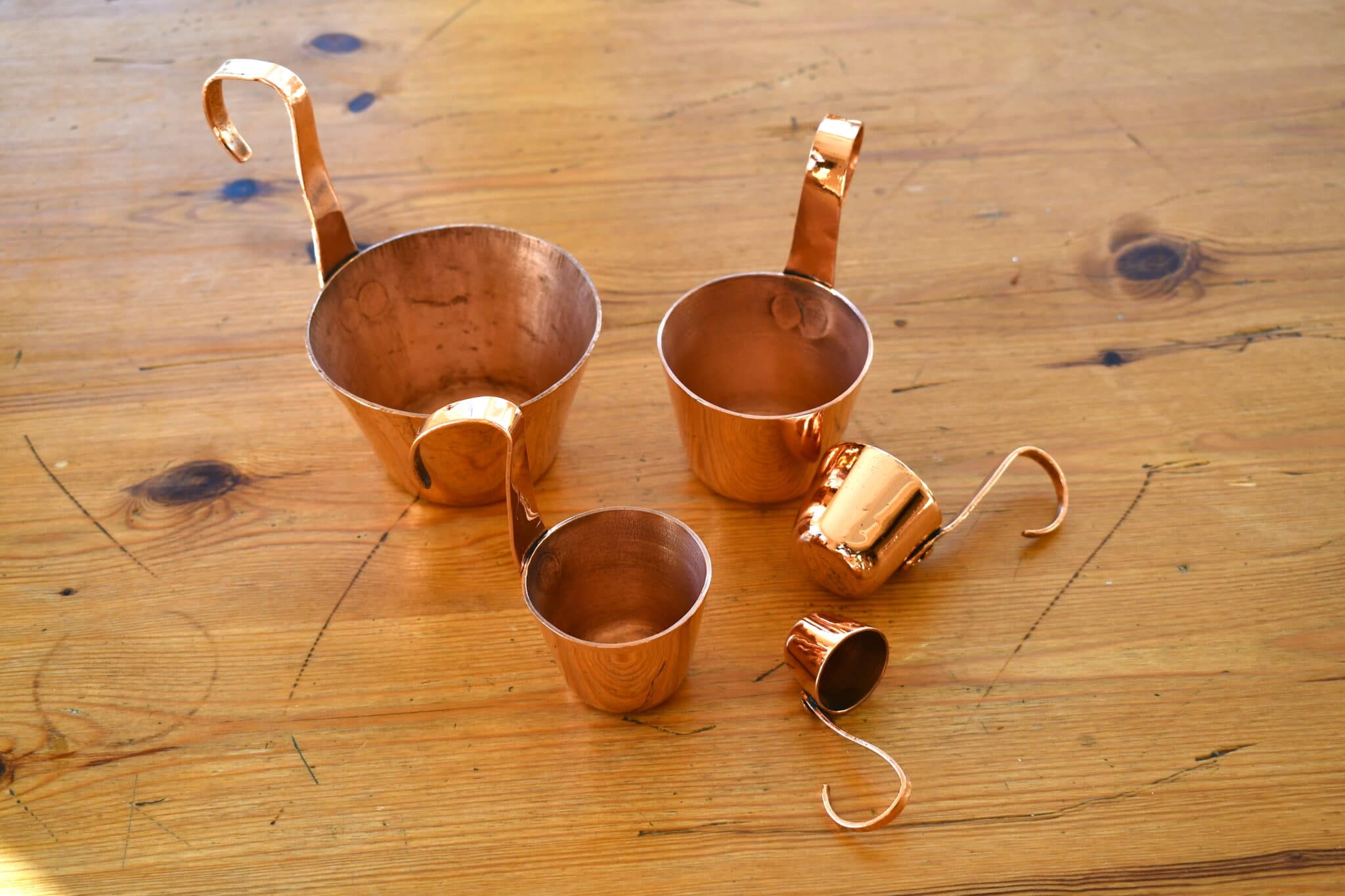This voluptuous piece is from Gaillard’s silver-plated orfèvrerie line.

| Type | Silver-lined round-bellied stockpot with brass handles |
| French description | Marmite bombée plaqué argent avec anses en laiton |
| Dimensions | 15cm diameter at rim by 18cm tall (5.9 by 7.1 inches) |
| Thickness | 1.0mm at rim |
| Weight | 1248g (2.75 lbs) pot body alone; 1544g (3.4 lbs) with lid |
| Stampings | Gaillard Paris with dashes |
| Maker and age estimate | Gaillard, 1930s-1950s |
| Source | FrenchAntiquity (Etsy) |
This is an absolutely charming piece. It’s an unusual shape that I have only seen in Gaillard catalogs, and always as a silver-plated piece (though a tin lining was an option). Below at left is a page from Gaillard’s 1914 catalog; the marmite bombée is at the upper right. In the 1956 Gaillard catalog below on the right, the piece is re-named marmite à potage. Of the two terms, I prefer marmite bombée for this piece as I feel the term better captures its curvaceous shape.


That’s not the only change from one catalog to the next. In 1914, the marmite bombée appears as part of several pages of bi-metal argent et cuivre (copper-silver bimetal) products. By 1956, however, the section is renamed orfèrvrerie de table — literally translating to, “jewelry for the table,” but colloquially referring to silver plated pieces. But I think the 1956 naming convention is a clue to the piece’s intended use: these are presentation pieces designed to be beautiful and thereby to encourage the appetite.
It’s undeniable — this bombée is a bombshell.


As are other pieces designated for table service, this marmite bombée is not made of thick copper. It is 1mm thick at the rim and based on its light weight it is likely a consistent thickness throughout. As its 1956 name marmite à potage suggests, this piece has a ladle-friendly shape designed to serve soup.
It was shaped on a spinning lathe. If you look closely at its contours, you can see tiny parallel lines that were left by the roller at the end of the shaping tool. A complex shape like this would have been formed over several steps with different mandrels to produce the desired final appearance.

The brass side handles are quite petite. To me this is another indication that this is a serving piece and not a cooking vessel. Compare the handles on this 15cm piece to those on my 16cm Lefevre Freres soup pot. That 16cm is about the same dimension, and at 1.5mm is not that much thicker, but the handles and rivets are twice the size of those on the bombée below.

The knob handle on the lid is not riveted in place but instead soldered. The join is a little messy, which suggests that it could have snapped off at some point and re-attached with silver solder.


I set the pot upside-down for the photo below so you can see how the rim has been formed. It looks like a rolled rim, a feature common on jam pans and turbotières and other pieces made from thin copper. A rolled rim has a reinforcing iron band within it to lend some structural rigidity to the piece. If there is a reinforcement inside this rim it must be tiny. It’s possible this rim has just been folded over and pressed flat.

The interior of the pot and the underside of the lid have been beautifully and uniformly plated with silver. There is some minor tarnish in the bottom (easily cleaned away should I care to do it) and around the outer edge of the lid’s rim. The interior is unblemished and I doubt this piece has been used for cooking.


This piece carries this Gaillard stamp — a very simple and quite small “Gaillard Paris” with two dash marks.

The examples I’ve seen with this same stamp are all similar: thin, lathe-spun, table-service orfèvrerie. (Gaillard offered these pieces with tin or silver lining, and I suspect some silver-lined pieces were subsequently relined with tin after the silver lining became worn.) Here are photos I grabbed from an online listing that show three more, including a marmite bombée that looks like the twin to mine.



I think these pieces are lovely — jewelry for the table, as the term orfèvrerie suggests. But the silver lining is not mere decoration. Silver is even more conductive than copper and is a thermally ideal metal for cookware. But in my opinion the downside to a silver lining is that it is electroplated and therefore quite thin — perhaps 15 microns, or 0.015 millimeter. (A tin lining is pretty difficult to measure — each is hand-applied — but Mac Kohler at Brooklyn Copper Cookware estimates his typical tin lining to be .2 millimeter or so.) This means that damage to the lining — scratches, scrapes, over-enthusiastic scrubbing — is more likely to penetrate through to the copper below, hastening the need for relining. I have heard that it’s possible for a retinner to lay down tin on top of silver, but if you wish to restore the original silver lining you will need to negotiate with an electroplating business for a one-off re-plating.
The same common-sense care that helps preserve a tin lining will also protect a silver lining. But remember, these orfèvrerie pieces are not intended for preparing food but instead for serving it at table. The silver lining makes good sense in this context: serving decreases the likelihood that the lining will be dinged or scraped. Used as intended, the lining will not only look beautiful but will also last.






Cute pot! I love your comparison of it’s shape to Marilyn.
In the picture of three, two to the left are likely potato steamers.